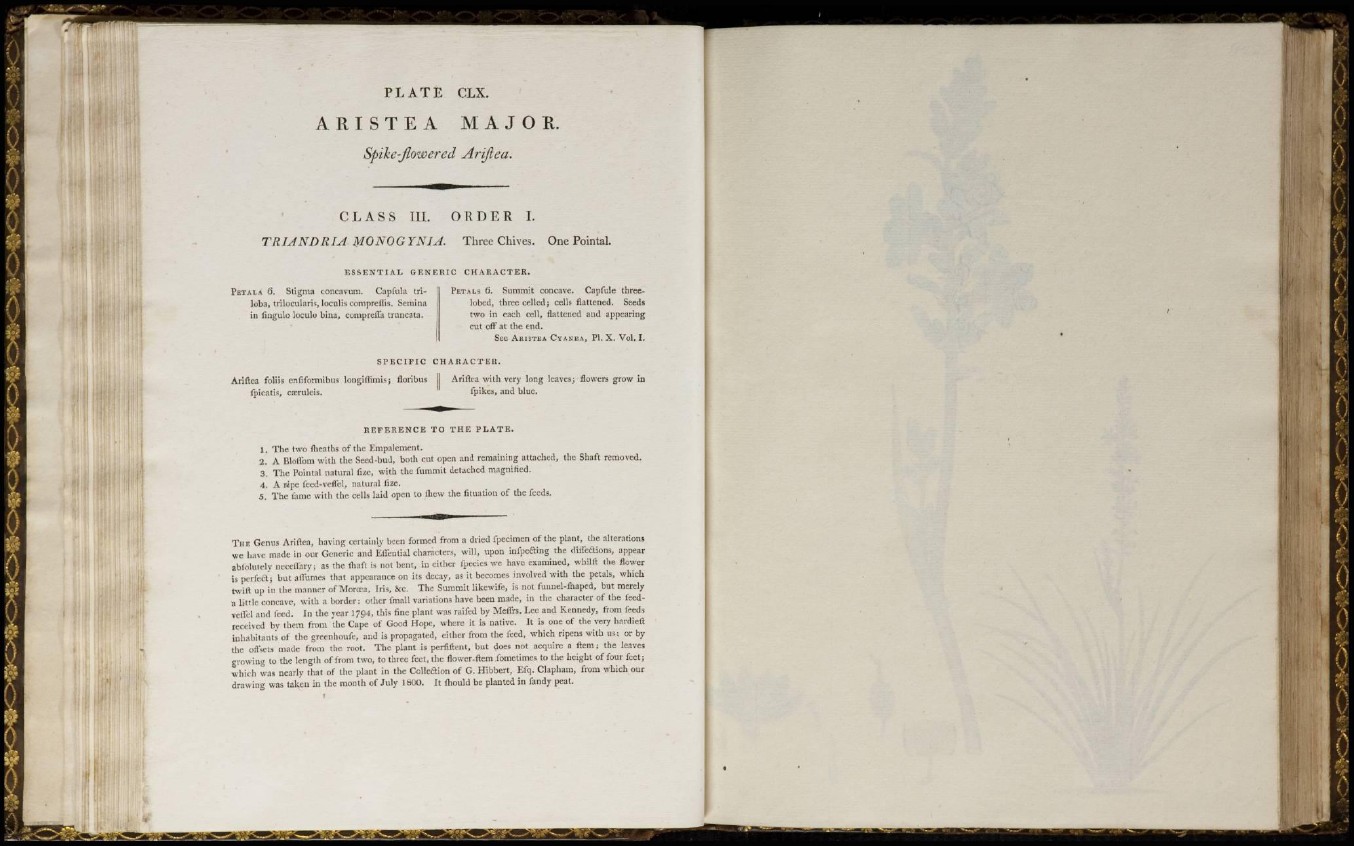
P L A T E CLX.
A R I S T E A M A J O R.
Spike-flowered Ariflea.
C L A S S III. ORDER I.
TRIANDRIA MONOGYNIA. Three Chives. One Pointal.
P É T A L A 6. Stigma concavum. Capfula tril
o b a , t r i . o c u l a r i s , loculis comprefiis. Semina
in i i n g u l o l ó c u l o bina, comprciTa t r u n c a t a.
R I G C H A R A C T E R.
P E T A L S 6. Summit concave. Capfule threelobed,
three c e l l e d ; cells flattened. Seeds
t w o in each cell, flattened and appearing
cut off at t h e end.
See A R I S T E A C Y A N E A , P l . X . V o l . 1.
S P E C I F I C C H A R A C T E R.
A r i f l e a foliis enfiformibus l o n g i i h m i s ; floribus | Ariftea w i t h very long leaves; flowers grow in
fpieatis, cicruleis. ipikes, a n d blue.
R E F E R E N C E T O T H E P L A T E .
1 . T h e t w o fheaths of t h e E m p a l e m e n t.
2. A Blotfom w i t h t h e Seed-bud, both c u t open and r e m a i n i n g a t t a c h e d , the Shaft removed.
3. T h e Pointal n a t u r a l fize, with t h e fummit detached magnified.
4. A nipe feed-veflel, n a t u r a l frze.
5 . T h e fame w i t h the cells l a i d open to fliew the fituation of the feeds.
T H E G e n u s Ariftea, having c e r t a i n l y been formed from a d r i e d fpecimen of t h e p l a n t , the alterations
we have made in our G e n e r i c and Elfentin! c h a r a c t e r s , will, upon infpecting the dtileflions, appear
a b l o l u t e l y u e c e i l a r y ; as t h e Ilia ft is not b e n t , in e i t h e r fpecies we have examined, whilft the flower
is p e r f e c t ; but a l l u m e s that a p p e a r a n c e on i t s decay, as it becomes involved w i t h the petals, which
t w i n up in the m a n n e r of Morcea, Iris, Dec. The Summit likewife, is n o t f u n n e l - i h a p e d , but merely
a l i t t l e concave, w i t h a b o r d e r ; o t h e r fmnll v a r i a t i o n s have been m a d e , in the c h a r a c t e r of t h e fecdvelfel
and feed. Jn t h e year ] 7Q4, this fine p l a n t was raifed by Mefl'rs. L e e and Kennedy, from feeds
r e c e i v e d by i h em f r om t h e C a p e of Good Hoj>c, w h e r e it is n a t i v e . It is one of the very hardier!
i n h a b i t a n t s of the g r e e n h o u f e , and is p r o p a g a t e d , either from the feed, w h i c h ripens w i t h us; or by
t h e onsets made from the root. The plant is perfihVni, but does not acquire a i t e m ; the leaves
g r o w i n g to t h e l e n g t h of from two, t o t h r e e feet, t h e flower-ftem fometimes to t h e h e i g h t of four feet;
w h i c h was n e a r l y t h a t of the plant in the Collection of G. H i b b e r t , Efq. C l a p h a m , from w h i c h our
d r a w i n g was t a k e n in t h e m o u t h of J u l y l&CO. It mould be p l a n t e d i n fandy peat.